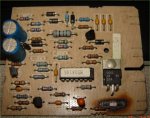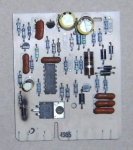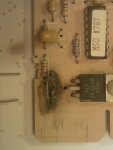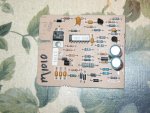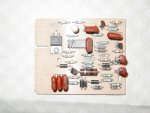Why not do it on the forums? Then everyone can learn!
Because I will be walking him lead by lead through the board, I need to know details about how it is acting. I think it would be cooler to post results and procedures rather than the guesses.
That being said, lets go over one of the most common failures and why it happens:
The -20 manual says in the glow plug system troubleshooting section, the resistance should be 6-10 ohms between the coil connections. (Table 2-4). We all know that the military changed the relay over to a heavier version much like our ST85 from NAPA.
Store Locator | NAPA Online
If you note in the specifications for the ST85, the resistance across the coil is 16-21 ohms, indicating either a much heavier coil, or many more turns than the original. The desired effect here is to create a stronger magnetic field to over come the heavier spring, and quickly and decisively close the contacts.
With heavy loads (80 Amps +) those contacts need to come together hard and fast, and with a heaver return spring, separate just as quickly. Otherwise, there will be arcing, welding and pitting on the surface of the contacts, and they will lose their conductive abilities and create a resistive load that will ultimately lead to failure of the relay.
Ever wonder why the monitor wire should be connected to the negative side of the relay instead of the positive side like the schematic in the -20 indicates? We know from previous posts that this monitors the voltage to the plugs, but why not take it from the other side, or even from the resistor bank? There are a few reasons, one of which, is that there can be a voltage difference between the positive side of the contacts, and the negative side due to carbon buildup, arcing and welding on the surface of those contacts.
To check this, wait until the relay is energized, and measure the voltage from the two contact terminals, these are the large terminals on either side of the relay. What you will be measuring is the actual voltage drop across the contacts. This measurement should be millivolts. Anything higher, and I would suspect bad contacts.
This can also be performed by removing the relay, and energizing it with a bench power supply, and measuring the resistance across the contacts, it should be milliohms.
Another cause of this damage is low batteries. With bad batteries, or a faulty charging system, the coils are just not getting the power they need to quickly close the contacts, the resulting symptom is a “chattering” of the relay. This is not to be confused with the normal cycling of the relay during the “post glow” or “after glow” period.
Now back to our ST85, we know that when a coil of any type is energized, it creates a magnetic field, also the reverse is true, when a magnetic field interacts with a coil, a voltage and a current is created, that is how the alternators work. So when energized, the coil creates a magnetic field, and closes the contacts. The next step is critical, when the contacts open, the residual magnetic field and movement of the contacts, induce a voltage that is very high, but a current that is very low, much like a spark plug, or static electricity.
This “kickback” voltage, is then conducted to wherever it can go, it can reach into many thousands of volts. One of the places it can go, is right back down the wire to the glow plug module.
The Glow plug module is protected from over voltage by zener diodes. As you may or may not know, a zener will act similar to a normal diode, allowing current to pass one way but not in reverse, but with a zener, it will conduct in the reverse direction when a preset or “breakdown” voltage is attained. Think of them as a pressure relief valve.
Looking at the circuit in the module, Q2 ( the large transistor) is the driver for the relay, from there the triggering voltage comes from the IC. But on some cards, just off of the connector for the relay ( right above Q2 ), there is a zener diode. This is not on all cards, why it is not, is beyond me. This zener diode (Z4) is designed to not allow the kickback voltage from the relay to damage any of the parts in the board. The lowest voltage tolerance of any of the components on the board is 36 volts, so they can withstand a surge up to that level. This zener, will “port off” to ground any voltage in excess of its breakdown voltage. In the case of my cards, this is 22 volts. I do not know if they are all the same.
Now remember, that while the kickback voltage is normally very high voltage, it is very low on current, this protection device is normally sufficient, however what happens in the case of a slightly larger current being conducted with the kickback voltage. Like could happen with a larger, heavier coil like the ST85 might have?
You might have guessed while there is excellent protection for voltage here, there is no significant protection from over current. What is protection from over current? A fuse.
These zeners are simply not designed to handle a significant current in while being reverse biased.
So to get back to the question of “what are the most common failures in a card?” I would first check that zener (Z4). Second, I would check the other zeners, as they would be the next most power sensitive. Third, as it would be first to be hit with an incoming current, I would look at the transistor (Q2). Then lastly the Chip (IC1).
There is no practical way to test the IC, so according to the KISS principle, save it for last.
In the case where Z4 is not installed, I don’t know why they did that. I can only imagine that they felt that the other zeners would be sufficient.
If there were no signs of damage, this process is where I would start. There are many sites online that describe how to test zener diodes and transistors.
Note that this is only one problem that can occur to damage a glow plug controller. We have just scratched the surface here. There are other failures possible in the truck that can cause the module to fail, but this one, due to our larger relay, is very common.
I do want to point out one more thing here. As designed, and operated in the manner for which it was intended, the Glow Plug Module is a very finely tuned circuit, and as with many 1980’s military analog designs, it is a very robust device.
When I see people on here worried about a “glow plug module failure” I cringe, for there is virtually nothing on this card that will fail with normal use. The point is, it is other things on the truck that fail, or operate outside of specifications that cause it to fail.
Attached are pictures from SS that show the Z4 failure.
Dog, give me a call if you have a chance.



